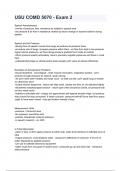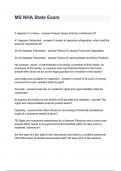USU COMD 5070 - Exam 2
Speech Aerodynamics
-mmnts of pressure, flow, resistance as related to speech prod
-air pressure & air flow in resistance created by larynx change in dynamic fashion during
speech
Speech and Air Pressure
-driving force of speech comes from lungs as produce air pressure there
-as reduce size of lungs, increase pressure within them - air flow from high to low pressure
region (atmos pressure), air flows along pressure gradient from inside to outside
-When produce speech articulately, have to precisely regulate pressures and flows in vocal
tract
-understanding helps w/ clinical probs where people can't valve air-stream effectively
Examples of Aerodynamic Problems
-flaccid dysarthria - neurological - weak muscle innervation. respiratory system - can't
produce enough pressure for speech- weak voicing
-vfs don't meet well= breathy and weak voice - air leak out fast, can't speak long on breath
so utterances short
-muscle tension dysphonia - larynx has high resist, causes low flow, bc vfs adducted tightly
-disordered velopharyngeal function - velum open when should be closed, air pressure leak
out thru nasal cavity
-inability to articulate well - tongue not approximate well against alveolar ridge, not produce
stop closure for stop consonant. If weak occlusion, pressure behind'll force itself thru space
ought to have been closed - may get frication instead of stop
Measurement Units
-pressure = force/unit area
-tire pressure: pounds/sq inch
-pascals, kilopascals measure pressure
-in speech research - cm H2O
U-Tube Manometer
-water in tube -if don't apply pressure to either side, water level identical on left/right arms of
tube
-if apply pressure, could displace water - measure ht difference of columns= # of cms of
water displaced by applied pressure
-can use to calibrate electronic equipment
-rather crude,isn't very good in speech prod - pressures go up and down fast - measures
static pressure
,Pressure Transducer
-for actual recs, need electronic devices
-clear polythene tube extends from white adapter, sticks into corner of mouth - can close lips
while speaking. for brief time, air pressure inside mouth rise and fall dep on consonant
articulating. can use device to measure intraoral air pressure during speech prod
Specialized Transducers
-some miniaturized
-measure pressure in esophagus -esophagus and trachea share common wall - early
researchers able to detect changes in driving pressure of lungs during speech production by
measuring pressure in esophagus - indirect measure, underestimates actual pressure, but
correlates well. not often used today
-measure pressure above, below vfs - not clinically practical
-most speech pressures in mouth and nose
-external transducer and sensing tube
Pressure Patterns in Speech
-When speak, various pressures measured dep where place tubing that attaches to
transducer
-P-io is intraoral speech pressure (equal to atmos pressure for vowels, elevated for
fricatives, highest for stop consonants)
-disorders may reduce pressure peaks -velopharyngeal insufficiency, flaccid dysarthria,
respiratory weakness
Subglottal Pressure
-abbreviate as Ps or Psub
-pressure that lungs provide - goes up trachea to larynx
-measured directly below larynx
-driving pressure that makes speech happen
-difficult to measure directly
Measuring Psub
• tracheal puncture
- direct, accurate measures during speech
- medical procedure, hole in trachea below larynx, mini pressure transducer inserted
- hard to attract volunteers!
• esophageal pressure
- shared wall: posterior trachea, anterior esophagus
- person swallows down pressure transducer partway into esophagus, sensor measures
pressures on shared wall of trachea and esophagus
- pressure lower than lung pressure
- not practical or common procedure
, Estimating Psub
when does oral pressure equal Psub?
• voiceless bilabial plosive
• vfs abducted - laryngeal devoicing gesture
• trachea and mouth are linked - no pressure drop at larynx
• pressure equalizes throughout system
• air pressure at min during vowel bc mouth open & air pressure equalizes btwn oral cavity
and atmos
Psub Values
• 5-7 cmH2O typical for normal speech
• 15-20 cmH2O for very loud speech
• clear association: Psub and SPL
-subglottic pressure = key contributor in adjusting
loudness or vocal intensity - larynx also make contribution by adjusting level of adduction
• lower pressure for pulse register
• higher pressure for falsetto
-vocal folds stretched tightly - stiffer & more difficult to displace, more pressure needed to
initiate vf oscillation
Phonation Threshold Pressure
• PTP - pressure needed for folds to start vibrating
• between 3-5 cmH2O needed to start, less to maintain
• PTP increases with:
- dehydration - vfs dried out/ less compliant, flexible
- vocal fatigue - vfs slightly swollen, more pressure to get to oscillate
PTP in the Clinic
• folds looser for easy onset
• folds stiffer for harsh onset
• PTP higher for abrupt start
• vocal fold lesions increase mass, stiffen mucosa
• PTP higher in many pathologies
- KERATOSIS or LUKOPLAKIA - stiffening of vf mucosal layer, often in smokers
Ohm's law... the sequel
• E=IR - relationship btwn voltage, current, and resistance (I = current/flow of electrons thru
wire, E = voltage of pushing force in electricity)
-voltage = subglottic pressure from lungs to drive voice
-electrical current = flow of air thru larynx during phonation
-Resistance = resisting force created by vf adduction
- pressure = flow x resistance





